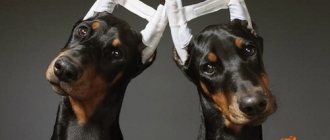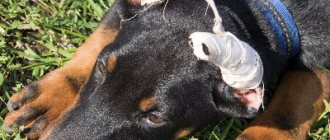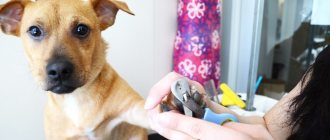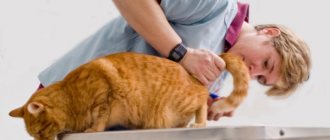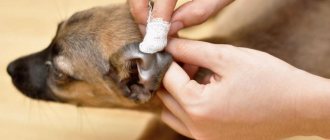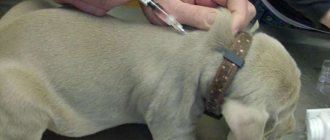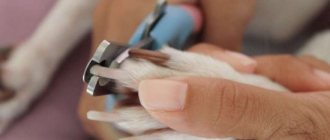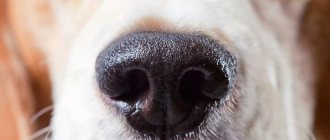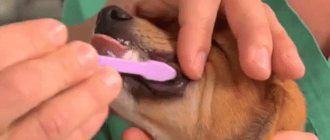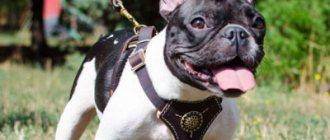Smooth, beautiful and well-set ears on a dog are a sign of a true breed. In some purebred individuals, the ears rise without problems already in puppyhood, while in others they remain drooping. The owners of such pets are trying to find a solution, but only a few know how to fix the dog’s ears.
Only a few know how to put on a dog's ears
Why do you need to put on dog ears?
Straightened ears are, first of all, a confirmation of the dog’s elite status. Dogs with long ears that stick out upward look more masculine and impressive. But this procedure is carried out not only for aesthetic reasons: dogs with erect ears are less likely to develop hearing diseases.
Some owners do not pay much attention to the ears, perceiving the puppy as he is. After all, the standards of some breeds imply both a straightened and saggy position.
If the lop ear is not the result of damage and is not a congenital mutation, the owner himself can correct it. But before studying the process itself, it is necessary to get acquainted with the breeds whose representatives’ ears are designed to stick up.
Important! It is especially important to have erect ears for those four-legged pets that are being prepared to participate in exhibitions. However, the decision about whether a pet needs ears installed always depends only on the desire of the owner.
Dog with erect ears
Dog breeds with erect ears
Dogs with erect ears are stately and beautiful dogs with an impressive appearance. But there are also very small, but no less courageous representatives on the list. Pointed ears sticking up have:
- Doberman;
- huskies and huskies;
- boxer;
- Australian Cattle Dogs;
- Shepherd dogs: Belgian and German;
- terriers: Scottish, Yorkshire, toy terrier;
- Spitz;
- miniature pinscher.
Nowadays, a dog of absolutely any breed may need to have their ears glued. Owners of Chihuahuas, pugs, and Yorkshire terriers often resort to this procedure. It is especially common to have to glue the ears of Boxers, Great Danes, Doberman Pinschers and Giant Schnauzers, since representatives of large breeds have ear problems much more often.
Doberman with correctly set ears
Important! Before installing ears on a pet, it is recommended that the owner consult with a breeder or specialist who has already gained experience in this area. He will help you choose the shape of the ear that will suit your pet and help with the first gluing.
At what age should ears go up?
In representatives of those breeds that have erect ears, the process of raising should begin from 2 months to 5 months of age. The exact age depends on the specific breed of dog. For example:
- Yorkshire Terrier: ear rises at 2 months;
- German Shepherd: at 4-5 months;
- larger breeds: 5-6 months.
If the pet’s ears do not rise within the specified period, the owner has to raise them himself using simple manipulations. But if a large dog’s ears are already lying in soft rags at 3 months and don’t even plan to rise, measures need to be taken already at this age.
Yorkshire terrier puppy
It is worth clarifying that in representatives of certain breeds the ears acquire a straight position quite late - at 6-8 months. You should consult your doctor to determine if your pet has difficulty raising its ears.
Important! Even if the ears have already begun to stand up, the process can slow down at any moment. Therefore, the owner must carefully monitor the pet’s ears. In some cases the process continues after a couple of weeks, but in some situations the ear may fall and not rise again.
German Shepherd puppy with drooping ears
Why is it important for your ears to go up?
Not all dog lovers choose to take a dog with them simply to complete their family. For some people they are a source of income, it is necessary that the "examples" respect certain characteristics and measures in order to meet the standard of the breed being bred.
If only one of the numbers is out of line, many puppies will be put up for adoption. But is it really important for their ears to go up?
To answer this question, you need to know the importance of their movement: a dog uses its body to communicate, and not being able to use its ears will be a hindrance for it in communicating with other dogs and people.
But there are dog breeds that require them to be dropped instead: hunting dogs or truffle dogs, in order to better smell and focus on exploration, have their ears dropped by nature.
This allows them to avoid being distracted by cues from the environment (and the forest will be full of noises that can distract them) and focus on their sense of smell.
© shutterstock
On the other hand, speech differs for a "show" dog or for those selected to maintain breed standards: even the angle of ear opening is calculated if it is turned too far to the right or left and, or less pointed.
But for many of us, who often choose the path of adoption, it is enough that our little friend is healthy, and everything else is indifferent, nature will take its course and sooner or later alert us.
Why do my puppy's ears fall off?
Every puppy at birth has small ears pressed against its head. The dog grows, develops, and the structure of the ears changes along with it. The cartilage in them becomes stronger, the auricles become larger, and the ears gradually straighten.
The size and shape of this part of the body cannot be changed: they will depend on heredity. But the strut can still be corrected if it is not caused by serious deformation. Otherwise, only a surgeon can help.
Puppies of different dog breeds
The ears may rise very slowly or remain drooping. In some cases, already raised ears may fall or stop rising for a while. The reasons may be:
- Deficiency of microelements and vitamins in the pet’s body. The main element that should be present in the diet of a growing dog is calcium. It is the basis for the construction of elastic and strong cartilage. If there is not enough calcium, all the microelement entering the body is spent on the formation of bone and dental tissue. It enters the cartilage last.
- Replacement of baby teeth. All reserves of the dog’s body during this period are aimed at the formation of strong molars. A smart body uses vitamins to create more important structure. Therefore, the cartilage in the ears simply does not have enough nutrition.
- Vaccination. If your pet has recently been vaccinated, the process of raising the puppy's ears may be delayed. This is due to the fact that injections are very stressful for a dog’s body. Do not worry: after the pet recovers from the procedures experienced, the process of raising the ears will resume.
Puppy vaccination
- Voluminous and fleshy ears. Even the strongest cartilage cannot lift ears that are too heavy and voluminous. Therefore, the owner’s gorgeous ears will need help.
- Purity of the breed. A purebred puppy should only be purchased from a trusted breeder. An unreliable seller can sell a mixed breed with deviations at the price of a purebred animal. And it is possible to straighten the ear cartilages of a puppy who was born from a mating between a purebred mother and a lop-eared dog in isolated cases.
In older dogs, the cartilage may sag due to injury that damages the cartilage. A dog may pinch or severely injure its ear during a fight with another dog. In this situation, you should contact a veterinarian. The further prognosis and ways to eliminate the problem depend on how seriously the ear was damaged.
Important! If a growing puppy’s ears still do not rise, then they need to be corrected as soon as possible. Otherwise, in an adult dog, the situation can only be corrected through surgery.
Puppy with soft ears curled to the sides
Bonding - pros and cons
The “gluing” method helps to radically make your puppy’s ears droop. It has proven itself in practice and is widely used for installing cropped and undocked ears on various breeds of dogs.
Some pets behave excitedly after gluing. They try to rip off the bandage and the structure with their paws, and rub their heads against the furniture. This way they can damage the ear cartilage and make the situation worse. In this case, you should loosen the tie and wrap or put on a special protective “collar” for the puppy.
Sometimes, after removing the adhesive plaster, an allergic reaction, pimples or scratches are clearly visible on the ears. Suitable for their treatment:
- baby powder;
- hydrogen peroxide;
- pharmacy blue.
After the ears have rested, the wounds have healed, and the crusts have dried, you will need to repeat the gluing procedure.
What to do if your dog's ears don't stand up?
Before taking your dog to the vet or trying to fix the ears with glue, you can try to solve the problem in other ways. These methods, along with descriptions of situations where they may be appropriate, are presented in the table below.
Table 1. Ways to straighten your pet's ears without gluing.
| Nutrition | Vitamins | Massage | |
| When to use | If the puppy consumes too little calcium or lacks the vitamins it received through its mother's milk. | In order for the cartilage tissue to begin to strengthen more actively, it is necessary to add special vitamins to the pet’s usual diet. | This is an auxiliary measure that by itself will not put your pet’s ears back in place. It is used in combination with a calcified diet and vitamins. |
| Description | You can supply a growing body with calcium by adding goat milk or cottage cheese, enhanced with this microelement, to your baby’s diet. Simple recipe:
| The most common vitamins include Polydex, Volmar, Beafarm, Kanvit, Excel, Canina, Calcefit. Side Plus works well for weak ears, but it is a rather expensive and rare drug. Another little-known drug is “Silver Trail” Calcium Peptide. These are vitamins with a plant composition that delivers calcium to the cartilage and bone tissue of the pet using the nano-method. It has excellent reviews from veterinarians. | You need to grab the base of the puppy's ear with two fingers. Then, with kneading movements, walk over the entire ear, moving towards the tip. It is necessary to carefully pull the ear up. In one session you need to perform 5-10 such massage techniques. It is important to do everything with gentle massaging movements so as not to cause discomfort in the dog. |
| Nuances |
| Before purchasing and taking the drug, you should consult a specialist. |
|
In the early stages of a puppy's development, all these methods can give good results.
The owner massages his dog's ear
Ear taping or what to do if massage doesn’t help
An owner who has already performed a massage and given his pet special vitamins, but has not achieved the desired result, should not agree to the operation without caution. You can try to refit your ears at home if the cartilage fold is not a serious birth defect or a consequence of injury. The procedure is quite simple and goes like this:
- Take a wide adhesive plaster (2-3 cm) and a few matches, non-sharp toothpicks or bath sticks.
- A frame is made from matches in the form of a small fan, which will support the cartilage of the auricle in a standing position. This frame is attached to the ears from the inside.
- The frame is fixed to the ears using adhesive tape. At first, the puppy will try to remove the structure that is new to him, so you need to distract him with food or games. Later the pet will get used to it.
Jellied recipe for dogs during ear setting
The longer the dog stays in such a frame, the faster the ears will rise. Small holes are made in the adhesive plaster to allow the skin to breathe. You should check your ears daily for redness or inflammation. If even slight irritation is noticed, the structure must be removed. If there are none, it is necessary to keep the frame as long as possible.
However, it is worth remembering that you cannot keep it for more than 6 days, even if everything is fine with the skin. After this time, the old patch is removed, after which the dog should be allowed to rest from it for about 12 hours. Then the adhesive tape is applied again.
Important! The effect will be most obvious if the pet starts walking in a frame from puppyhood: immediately after the owner sees that the ears do not rise. A similar device can correct the position of the ears in an adult dog, but the procedure will not be as effective.
Puppy with a frame on his head
Is it safe to glue dog ears?
If the gluing procedure was carried out correctly, it will not cause any harm to the pet. A dog owner who does not yet have any experience with ear gluing is recommended to entrust the first gluing to a breeder or veterinarian. This “operation” is carried out many times, so the owner still has time to learn how to do it on his own.
It is recommended to entrust the first gluing to the breeder or veterinarian
However, there may be side effects, among the most common it should be noted:
- an ear covered with a plaster, in which blood circulation is disrupted;
- allergy to the adhesive coating of the adhesive plaster;
- fixation of the ear in a position that does not correspond to the breed standard;
- the development of bacteria and the appearance of irritation in the ear;
- discomfort and pain when removing the adhesive patch.
Important! For the first few days, you need to monitor your puppy's reaction to the adhesive bandage. An owner who spends enough time with the puppy every day will immediately notice the puppy’s anxiety, itching in the ears, redness or an unpleasant odor. All this may signal that inflammation is developing under the structure and the patch needs to be removed urgently.
Dobermans from the same litter with glued ears
Why should they be installed?
Placed ears as an indicator of the breed are a necessary attribute for a puppy planning a show career. To obtain a place of honor, erect ears are considered a necessity for:
- Spitz-shaped;
- Australian Bouvier;
- terriers;
- Dobermans;
- pinschers;
- German and Belgian shepherds;
- boxers and a number of other dog breeds.
In addition to the aesthetic point of view, it is important to note the medical one. If the ears are erect, then the likelihood of hearing diseases is reduced. Pathogenic microflora develops more often in lop-eared representatives deprived of natural ventilation.
What to do if your dog doesn't have ears?
Knowing why the rise does not occur, you can try to help your pet at home:
- Review your diet. Calcified nutrition helps strengthen the puppy’s cartilage tissue. Focus on natural cottage cheese and goat milk. Gelatin is no less beneficial for cartilage, so treat your pet with jellied pork ears.
- Buy vitamins (such as Volmar, Kanvit, Calcefit, Silver Trail, Polydex, Beafarm, Canina, Side Plus). Don't make any choices without your veterinarian's approval. Properly selected vitamins will eliminate the deficiency of substances and strengthen the pet’s bone and cartilage tissues.
- Make sure there is sufficient blood supply. You can install the ears using a special massage that accelerates blood flow and is performed on a daily basis:
- Grasp the base of the ear using 2 fingers.
- Start massaging the ear tissue, moving from the base to the tip.
- Use smooth movements and gently pull the ear upward.
Don't forget about the comprehensive methodology. If you choose only one of the proposed methods, the desired effect cannot be achieved.
Please note that the proposed methods only work at the initial stage of development. If the dog does not show results, then do not rush to undergo surgery. In the absence of serious injuries or birth defects, gluing will cope with the task.
How do you know if your dog's ear needs to be taped?
So, the owner noticed that the puppy’s ears do not straighten out well, they fall inward towards the top of the head or stick out to the sides, and dangle when walking. Now we need to find out whether the ear can rise on its own or whether gluing is required.
Step 1. Determine if there are any creases
It is necessary to carefully examine your pet's ear. If it collapses at the very base, it definitely needs support. Such an ear will definitely not rise without the help of the owner. It must be completely straightened and glued directly at the base in such a way as to completely prevent it from collapsing. The ear should be vertical.
A standard knob looks like a horizontal section with a very thin layer of cartilage. The ear cannot hold up normally and breaks in this thin place, falling forward. This situation can be prevented by feeding the animal calcium from an early age. But if a crease has already formed or is just emerging, it is necessary to glue the ear.
Dog with a crease in the ear
Step 2. Looking for scars and weak spots
If there are no creases, but the ear still falls down, it is necessary to examine it for scars and weak spots. Such areas inhibit development and prevent the healthy ear from rising. The inspection algorithm will be as follows:
- Squeeze the ear at the base with your thumb and forefinger. Start feeling it from bottom to top with your fingertips.
- Find the weak point that prevents lifting. It could be a small speck or a strip of thin fabric. To make sure this is the right place, pinch the spot between your fingers. The ear will rise and straighten as you hold it in this problem area.
- The spot located in the upper part of the cartilage does not require gluing. It is enough to start giving your pet vitamins to restore cartilage tissue. The ear will straighten and become stronger without outside help.
- If the weak area of the tissue is located in the middle of the ear or at its base, gluing is necessary.
If the owner has not found any weak points, but the ear is soft in itself and collapses completely, gluing will not solve the problem. It is necessary to first carry out a course of restorative treatment with vitamins and calcined products. When the cartilage becomes strong and complete, you can start gluing it if it does not rise on its own by that time.
Puppy with house ears
What to do if a sulfur plug has formed
A large accumulation of earwax that blocks the ear canals is called cerumen plug.
This problem can arise for a number of reasons: lack of care, improper care, body characteristics, physical condition of the dog, and others. Signs that a dog has wax impaction are:
- hearing loss (the dog does not respond immediately to the owner’s call, or does not respond at all, and poorly follows commands that it knows well);
- absent-mindedness, apathy;
- the dog scratches its ear and shakes its head;
- the pet asks the owner for help or, on the contrary, is irritated;
- head tilted to one side.
In any case, you need to go to the clinic, where the doctor will conduct a professional examination, if necessary, otoscopy and other auxiliary manipulations. Once the diagnosis is confirmed, appropriate treatment will be prescribed. The plugs are usually removed in a few minutes and do not require repeating the procedure. The doctor will either rinse the ear or clean it using the necessary tools.
Carefully! It is not recommended to wash your dog’s ears yourself, as this can cause inflammation or simply fail to remove the wax plug.
We put ears on different breeds of dogs
The basic principles of gluing are the same for all individuals, but there are also some nuances. Let's look at the most popular breeds.
Chinese Crested
The Chinese Crested is a dog with long and fluffy hair that even grows on the ears. Before gluing the ears of a representative of the breed, it is necessary to cut off all the hair from the ears. This will solve two problems at once:
- create closer contact between the patch and the pet’s skin;
- minimize discomfort when removing the adhesive tape because it will not pull out hair.
Chinese Crested Dog
A dog with bare ears will not be as adorable as before, but the owner should not worry. Once the ears are set, the fur will grow back.
Gluing the ears of a miniature dog
Yorkshire Terrier
To glue the ears of a Yorkshire Toyerier, simple textile glue is suitable, since the ears of representatives of the breed are quite light. The only rule is that the glue needs to be trimmed regularly and the pet’s ears must be given a day of rest. Then you can apply the composition again.
Important! The ears of Yorkshire terriers must be freed of hair before gluing, just like the ears of a Chinese Crested.
Yorkshire Terrier
German Shepherd
The “Germans” have ears that are usually quite strong and stand up on their own. However, for the proper development of cartilage, they also need to be fed with calcined foods and supplements, and massaged regularly.
Two German Shepherds on a walk. One has straight ears, the other has droopy ears.
Doberman
Doberman owners have a difficult job ahead of them. Owners who have already fitted ears for representatives of this breed know how important erect ears are for these dogs.
Dobermans have their ears installed one day after docking. The wound that remains after surgery tightens the ear, thereby deforming it. The ear begins to fall and will not get back up on its own. Strong Dobermans are best suited for “crowns” made of wire, which are attached to the ears.
Algorithm for gluing Doberman ears using a special metal frame
Important! The Doberman is an active and playful dog, so you need to make sure that he does not rip the structure off his head.
Toy Terrier
According to the breed standard, the Russian Toy Terrier must also proudly display erect ears on its head. Most representatives of the breed have very small ears, so it is recommended to use broken matches for the frame. Make sure their ends are not sharp.
The most suitable algorithm for gluing the ears of a toy terrier looks like this:
- cut the adhesive plaster according to the shape of the ear;
- stick it on the inside of the ear, and then attach a splint of matches to it;
- Apply another layer of adhesive tape on top.
Important! It is permissible to completely remove the frame only after all of the toy terrier’s milk teeth have been replaced by molars.
Toy Terrier. Bonding
How to install undocked ears on small dogs: detailed instructions
Problematic uncropped ears in representatives of all small or decorative breeds are diagnosed by analogy. Let's study the procedure in detail using the example of the Chinese Crested. You can begin setting up the ears of a representative of this breed as early as one month of age.
Table 2. Algorithm for setting ears for miniature dog breeds.
| Stages | What do we have to do |
| Step 1 | Find an assistant to help restrain the dog. Long hair will have to be shaved off, and the dog's head will need to be held still so as not to damage the delicate skin on the ears. |
| Step 2 | Prepare the trimmer, secure the dog and shave the hair from the inside and outside of both ears. Ears that are completely free of hair will become much lighter, and removing the adhesive bandage will be less painful. |
| Step 3 | The sound and vibration of the trimmer may frighten your pet, so during the procedure you need to constantly reassure him and talk to him gently. You need to work very carefully. At the base of the ear on the inside there is a thin partition that should not be touched at all. |
| Step 4 | Use scissors to trim off the remaining hair around the edges of the ear, then wipe the cartilage inside and out with alcohol or another degreaser. This way the patch will stick better. |
| Step 5 | Separate a piece from the patch corresponding to the length of the ear. Place it on the table in front of you with the adhesive surface facing up. Measure the cotton swab along the length of the ear, cut off the required length and place it on top of the adhesive plaster. |
| Step 6 | On top of the cotton swab, you need to stick two more layers of the patch of the same length as the first. Cut the resulting “tire” to the shape of the ear so that the fleece points down. |
| Step 7 | Stick the resulting structure on the inside of the ear so that the ear canal is clearly visible. Wrap the ears in the form of tubes, but without enthusiasm, so that the dog does not experience discomfort. Repeat the algorithm from the very beginning with the second ear. |
| Step 8 | Wrap each ear at the base with adhesive tape. There is no need to bring your ears close to the top of your head, as this may cause them to stand up incorrectly. The dog's muzzle along with the structure should look natural, the ears are straight and stick up. |
With such a design on the head, the pet will have to walk for about 5 days. After this, the patch must be cut and carefully unscrewed, freeing or cutting off the stuck hairs. Sometimes the ears stand up after the first procedure. If the desired result is not obtained, after a day's rest the procedure must be repeated from the first step. You can carry out the procedure until the ears are completely straightened.
The process of gluing the ears of a Yorkshire terrier
Important! The Chinese Crested breed has two varieties - fluffy and hairless. The ear straightening algorithm is suitable for each variety. The breed standard states that the Hairless Crested must have ears extended upward, and for the downy breed any arrangement is possible. However, breeders are confident that the downy Chinese Crested with erect ears looks much prettier.
TOP dogs with long ears
Large breeds, smooth-haired
African Greyhound
Another name is "Azawakh". Refers to large-breed greyhounds with smooth hair. Standard height is up to 76 cm for males. Adapted to hot climates. The muscles are strong and sinewy. Covers long distances. The head is long, the nose is elongated. The ears hang down to the sides and are very mobile. Due to this, the greyhound quickly reacts to a stimulus signal (noise, crackling, sound). Used for hunting large animals, as a beater.
Bloodhound
The breed was bred in Belgium as a guardian of monasteries. Later used as a big game hunter. It is distinguished by its unusual head shape and pronounced brow ridges. The coat is smooth and lies very tightly. The ears are set very low, soft, long. It grows up to 70 cm at the withers with a weight of up to 54 cm. It has a complex character and is difficult to train. It looks ideal for intimidating the enemy, but it will not be able to attack first.
German dog
A graceful specimen, over 70 cm tall, with shiny fur that fits tightly to the body. A muscular, lean dog with a calm character is considered a true aristocrat among all Wolf dogs. Gets along well with people and pets, loves family and children, it is almost impossible to keep them off balance. The head is round with soft drooping ears. The muzzle is square, the eyes are expressive. Does not require much care, loves to contemplate and observe the outside world. Suitable for keeping in large apartments and country houses. It is a true home decoration. The character is very calm, understands commands, a person’s words, and quickly remembers them.
Pointer
A smooth-haired pointer from Great Britain, large in size, up to 65 cm. Outwardly, it slightly resembles a Great Dane, but differs in its spotted color. The character is active. The dog is a passionate hunter, loves to run and exercise with his owner. A groove runs down the middle of the skull, dividing the muzzle into two halves. On the sides hang long, smooth-to-the-touch ears that feel like velvet. Superciliary ridges, an attentive gaze and a slightly upturned nose are what distinguish the Pointer from other pointers. He quickly learns commands and treats his family well.
Rhodesian Ridgeback
Initially bred as a guard breed for working with slaves, then it was used for hunting elephants. A stately dog with a characteristic crest on the back, which consists of guard hairs growing in the other direction. Tall stature and strong limbs turn the Ridgeback into a hardy dog, capable of covering vast distances. The ears are located on the sides on the top line of the head and hang down to the middle of the cheeks. Guard instincts are highly developed. He learns quickly, loves activity, and is loyal to children and pets. Knows how to make friends with other pets. The best conditions for upbringing are a flock of their own kind.
Porselen
A rare breed of dog called the Porcelain Hound. The muscular body is covered with dense hair. A well-proportioned physique with a developed sternum and toned stomach make her look graceful and royal. The ears are very long, hanging almost to the end of the neck. Soft, silky. When running, they look like the wings of a bird. The character is soft, calm, good-natured towards members of the household. The level of aggression is noticeably reduced, but they are independent. He may not obey, run away, act out. Parenting requires patience, perseverance, affection and time.
Longhaired, Wirehaired
English Setter
Bred in England as a hunting dog for wild birds. The size is large, the height at the withers reaches 68 cm. The appearance is elegant, the running is easy. The ears are long and covered with wavy hair. The location of the auricle allows protection from dirt and water. After bathing, you need to comb it. The character is good-natured, sympathetic, soft. Loves activities, always next to a person.
Bobtail
It is called the "Old English Sheepdog". A massive dog with a height of 55 cm. Covered with thick white curly hair with black spots, which has water-repellent properties. Tolerates bad weather well. The ears are medium in size, fit tightly to the skull, and hang down. Bobtails are distinguished by a characteristic bark with a slight hoarseness. They resemble a good-natured bear who loves to play with children and run around. Easily socialized at the dog park.
Drathaar
Wirehaired pointer from Germany up to 68 cm tall in males. A hunting dog that faithfully serves the family and owner. Low level of aggression, does not know how to get angry. The coat needs trimming, otherwise the dog looks unkempt. The ears are located on the sides, hanging down to the middle of the neck. They are soft, pleasant to the touch, dark brown in color, while the body is covered with coarse white-brown hair, vaguely reminiscent of gray hair.
Italian spinone
"Gun" breed, classified as large continental griffins. The sides of the head are inclined, the skull is oval. The ears are very long and triangular in shape. Hangs below the throat with thick, sand-colored hair. They are considered universal dogs for hunting in different climatic conditions. They quickly get used to commands and obey their owner. The sense of smell and hearing are sensitively developed. Ways to protect the territory, but do not have pronounced aggression.
Saluki
The Greyhound originates from Persia and is recognized as one of the oldest hunting breeds. Tall and stately, with a toned torso and developed limbs. There are short-haired and long-haired. In the latter, the fur fits very tightly to the body, while the ears, tail and legs are covered with long feathers. When running, he reaches a speed of 70 km/h. Capable of hours of pursuit. She has an independent character and is difficult to train for a general command course. You need long walks and runs to release energy. They rarely bark and are wary of strangers.
Saint Bernard
A massive dog with thick, long hair with undercoat. Used as a guard, cattle driver. He has an excellent sense of smell and carries out commands to save a person. You can trust him with your home and children. The character is flexible. The head is large, proportional, the ears are large, drooping, covered with feathers, soft. This is a person's true friend who will always be there.
Medium-sized breeds with smooth coats
Basset Hound
One of the most sedate breeds in behavior, whose ears hang almost to the floor. The exterior with numerous folds on the paws, the expression of the muzzle, and the carriage of the head are considered the “calling card” of the dog. Used for group driven hunting and blood trail pursuit. Medium size, from 33 to 38 cm. Hardy due to muscular build. With age they become slow and lazy. Prone to overeating and obesity.
Beagle
The breed is medium in size (up to 40 cm) with short, close-lying hair. Externally it looks compact. The ears are elongated and soft. When measuring the standard, they should reach the tip of the nose. They were originally bred as hunters. Today these are companion dogs who gladly take part in games and entertainment. Get along with other pets. The character is cheerful, active, easy to train.
Longhair
Cocker Spaniel
There are two types of height: English and American. They were bred as a universal hunting dog with the best qualities. Today it is more used as an ornamental breed. The head is oval in shape with clearly defined brow ridges, with a transition from the forehead to the nose. The ears are elongated, widening towards the bottom, set at the temporal bone. Covered with thick soft long hair with curls. He has a friendly character with hunting instincts.
Small breeds with curly or long hair
Bichon Frize
A small dog of French origin. Outwardly, it resembles a fluffy toy with curly hair. Ears are drooping. Due to their well-developed hearing, they are sensitive to extraneous noise. They love to play with people. Constant brushing is required, as long hair curls, forms tangles, and is difficult to untangle. According to the standard, only snow-white color is allowed, with small yellow spots possible.
Poodle
Decorative breed with three subspecies: large, medium, small. They are distinguished by thick curly hair with small curls. Professional haircut required. Large representatives grow up to 65 cm. The exterior is graceful, the gait is light and springy. Capable of jumping high and running at lightning speed. They learn commands the fastest and show a keen interest in everything that happens. They cannot imagine their life without a person.
Shih Tzu
The oldest breed from China, which is called the “Beauty Dog”. Its small size (up to 27 cm) makes it look like a fairy-tale hero or toy. Long, beautiful hair hangs down the sides and covers the paws, muzzle, and ears. On the nose it sticks out slightly, which makes the muzzle look like a chrysanthemum. Attentive eyes like beads attract with their genuine beauty. A decorative dog that requires constant professional grooming. She loves affection, is dependent on people, and tries to always be there. The character is too friendly, no aggression, does not know how to protect, but serves as an excellent addition to those who love small dogs.
Smooth and wirehaired
Dachshund
A hunting breed, which is divided into three subspecies according to the size and properties of the coat (smooth-haired, wire-haired and long-haired). The ears are long, wider at the base. The head is oval, the nose is pointed. Has a high level of hunter-pursuit instinct. He is wary of strangers and children and cannot tolerate noise. The character is mischievous, very active. Requires observation by a veterinarian due to the specific low position of the elongated body on short limbs.
How to place cropped ears: detailed instructions
Cropped ears that stand beautifully and correctly are considered a real work of art. They should not gather on the head in the form of a “house” or fall on both sides of the head. Ears after cropping can begin to be set only when the cut edge is completely healed.
Option 1 - soft design
The most problematic part of the procedure is the straightening of the cartilage located at the very base of the ear. We will study the algorithm that will be correct when straightening cropped ears using the example of a representative of the Miniature Schnauzer breed.
Table 3. Algorithm for setting the ears of a dog of the Miniature Schnauzer breed.
| Stages | What do we have to do |
| Step 1 | Fix the dog's head and free the ear from hair using a trimmer, degrease the ear with alcohol. |
| Step 2 | Use two fingers to grasp the tip of the ear, then pull it up and slightly back. This is necessary to straighten the cartilage at the base on which the entire ear rests. |
| Step 3 | Twist both ears into a tube one at a time. Right - clockwise, left - counterclockwise. |
| Step 4 | Wrap a wide adhesive plaster around the twisted ear, holding it firmly by the tip. You need to wrap it starting from the base and reaching the tip. |
| Step 5 | Check the cartilage at the base of the ear: it could have become bent during work. Make sure that the ear canal is not closed, the puppy hears well, and the ears do not swell under the patch. |
| Step 6 | The ears wrapped in adhesive tape must be secured together so that they stand straight. At the base they are horizontally wrapped with adhesive tape and connected to each other. Make sure that the design looks natural and the ears stand upright. |
The pet will have to wear the resulting “horns” on its head for 5-6 days. Then the patch is carefully removed. If you were unable to place the ears the first time, they need to be re-wrapped after 1-2 days. Repeat the procedure until the Miniature Schnauzer's ears stand upright.
Miniature Schnauzer puppy
Option 2 - rigid structure
Another way to straighten cropped ears in large breed dogs is to make a rigid frame. These two types pursue the same goals, are similar in execution algorithm, but differ in the necessary materials.
You can build a solid structure with your own hands. For this you will need:
- foam curlers that will support the ear from the inside;
- a wooden stick to avoid getting your hands dirty when applying glue;
- popsicle sticks to guide and hold the ear;
- medical glue for fixing curlers;
- pharmaceutical fabric adhesive plaster for final treatment.
Instead of fabric adhesive tape in this case, construction tape or masking tape will do. It is important to ensure that the glue does not get into the ear hole. The ears, as in the previously discussed cases, must be shaved and degreased with alcohol.
German Shepherd in a tight frame
Staging methods
Ear fitting for dogs is carried out using soft and hard structures. Both methods have the same goals and similar execution techniques, but differ from each other in the materials used.
Rigid design
The rigid design is used for large dog breeds and long cropped ears. You can make it yourself from scrap materials or buy it at a pet store. To create a basic hard “crown” you may find it useful:
- foam rollers for the liner;
- medical glue will help to glue the curlers;
- a pencil so as not to get your hands dirty;
- Popsicle sticks for rigidity and as a guide line;
- General fixation will require medical or surgical tape. Reinforced construction tape or masking tape will also work.
Make sure that the glue does not get into the animal’s ear canals and do not forget to first remove hair from the ears and degrease them with an alcohol solution.
Soft design
This setting option is suitable for small breed puppies. It provides for gentle gluing without glue or complex rigid fixations. Making gluing using a soft structure is not difficult.
The necessary materials are a 3 cm wide adhesive plaster and cotton swabs (for rigidity). As in the first case, the fur from the ears must be shaved off and the ears wiped with alcohol, otherwise the procedure for removing the adhesive tape will cause pain to the puppy.
There are many options for gluing and setting ears. Any materials can be used: sanitary tampons, cut-outs from plastic cards, pen refills, plastic bottles and foam sponges.
The main rule is do no harm. It is important that the devices do not injure the puppy, are durable and light, so that they are easy to install and not difficult to remove.
Setting up ears for an adult dog
When a dog turns one year old, the cartilaginous tissue in the auricle finishes forming. If by this age your pet’s ears have not stood up, nothing can be fixed. Neither massages, nor feeding with calcined cottage cheese, nor vitamins will help. Gluing can slightly correct the shape of the ear, but the creases cannot be corrected.
The only way out in this situation is plastic surgery. If the owner wants to make the pet's ears erect at all costs, he will have to put the dog on the surgeon's table. Nuances of the upcoming operation:
- The desired effect is achieved by trimming the animal's skin in the forehead area.
- Sometimes, after the first operation, the ears do not stand up as they should, so you will have to perform a second, and, if necessary, a third.
- The effect of erect ears can also be achieved by sewing a whalebone or implant into the auricle.
At the stage of preparation for the operation, the owner needs to analyze all the pros and cons. Even purebred individuals whose ears were installed through surgery cannot participate in breeding, and the consequences of surgical intervention can be completely unexpected.
An adult Doberman whose head is decorated with a homemade design
Is it possible to put ears on an adult dog?
You should not try to find information on how to install the ears of an adult dog. After 1 year, all popular methods stop giving results. This is due to the fact that the cartilage tissue no longer changes.
The only possible solution is plastic surgery, but it carries a lot of risks. To achieve the desired shape, you often have to resort to repeated surgery, the consequences of which do not always justify the final result. It is equally important that operated pets are excluded from breeding.
What are the types of erect ears?
Each puppy is born with tiny, neat ears gathered on top of its head. As the puppy grows, the ears straighten and rise if the pet's food contains enough nutrients and calcium.
The rising ears can take different positions:
- “helicopter”: ears hang in opposite directions;
- “house”: bend towards the middle and converge in a triangle above the top of the head;
- different positions: it happens that a puppy holds his ears completely differently - for example, one bends towards the top of the head, and the other stands vertically;
- vertical: the most favorable position is when the ears stick out with their tips up.
All of these ear positions are considered normal in growing puppies. In the future, the ears will finally form and rise in the right direction.
As your puppy grows, his head gets larger, and so does the space between his ears. At about 4 months, a puppy's ears already reach the size of a large dog's ears and seem too massive for a child's head.
Different ear positions in dogs. 1 - helicopter, 2 - house, 3 - in one direction, 4 - drooping ears
If at this time the cartilaginous tissue in the auricle is sufficiently dense, then the ears rise without any particular difficulty. Gradually, the angles of inclination in the “house” and “helicopter” positions will decrease, the sharp part will begin to rise, and the ears will straighten until they reach the end point.
Cartilage that is too flexible may not be able to cope with the weight of massive ears. In this case, the sharp half of the ear, instead of straightening out, will bend more and more from the very base.
Adult dog with drooping ear tips
What should the owner pay attention to?
Forming the position of the auricle is the most important process in raising the ears, so the owner needs to carefully monitor how this happens. Nuances to pay attention to:
- The bending lines of the tilted ear should be smooth and resemble an arc, and the tilt should decrease by several millimeters every day. An ear bent to the side or towards the top of the head at an acute angle indicates a crease. The pet needs prompt help in the form of gluing and an auxiliary course of vitamins.
- If ear development has reached the “house” position, be extremely vigilant. This is a standard method of lifting, but if the ears remain in this state for too long, the problem needs to be corrected. There is a risk of developing a difficult-to-remove crease at the beginning of the ear. If the dog is not helped in time, the ears may remain curled towards the top of the head for the rest of his life.
Puppy with house ears
- Even at the final stage there are unpleasant surprises. For example, the ears were almost up, but the owner noticed a small fold on the shell of the ear. If it is not eliminated in time, a scar or crease will form in this place. Urgent gluing is necessary so as not to miss the moment.
- If the auricle has already fully expanded, but has fallen off after changing teeth or for some other reason, you need to wait. Ears that do not straighten again after 10-14 days need to be given additional support. Some experts even believe that it is necessary to feed your pet vitamins and glue the ears immediately after they fall off.
- A lot of ear problems originate from too soft cartilage. In some cases, the ear rises, but does not look strong and sways when walking. The tip of the ear may sway or bend. The gluing will not be able to correct loose cartilage: in this case, calcium and vitamins are needed.
A crease in a dog's ear
How to teach your pet hygiene
The success of various manipulations to care for the ears of your four-legged friend depends entirely on the correct training of the dog for such procedures. A caring owner must remember this and start raising his pet as early as possible.
Warning! Accustomed to grooming (full necessary care for the pet, carrying out all hygienic manipulations to maintain health and a beautiful appearance), the dog is less nervous, spins around and tries to escape, and sometimes even bite the owner while cleaning the ears. This makes the care procedure more comfortable, safe and quick for both the pet and the owner.
Even from puppyhood, you need to make it clear to the pet that the owner will never cause harm. You need to become an authority and a kind patron for the dog. To gain trust, you need to come from afar - first touch the ears, rake the fur, lightly press on the ears and the skin around them, but so as not to cause pain. Show the puppy all the tools that will be used in grooming and let him sniff them.
External examination of the dog's ear
You definitely need to speak in a gentle tone, encourage and praise your pet. It is useful to stock up on treats and, after feeling and examining the dog, reward it for good behavior.
If the puppy is worried, you cannot forcibly hold him down or scold him. It is better to let him go so that he understands that he can leave and come freely, but it is important to feel the line where freedom ends and arbitrariness begins.
That is, it is important to make it clear that no one will offend the puppy or force him to do unpleasant things, but he, in turn, is obliged to obey and perceive any actions of the owner as necessary. Only after reaching mutual understanding and complete trust can you begin further more serious actions, such as brushing your teeth, cutting your hair (for some breeds), washing your eyes, and washing your nose.
An important point: if necessary, you can accustom an adult or even an elderly dog to grooming. It will be a little more difficult, but it is quite possible to achieve excellent results. It is important to take into account the nature of the pet’s breed, show patience and perseverance.
Installing dog ears at home: expert advice
Each puppy has its own characteristics, so the ears of even representatives of the same breed can be formed completely differently. But general principles on how not to harm a puppy still exist.
Before the procedure, wipe the dog’s ears with alcohol.
Qualified doctors advise owners who are worried about the position of their pet’s ears to adhere to the following rules:
- Never pet a puppy on the head. All family members, including children, need to be weaned from this. The fact is that such stroking forces the dog to press its ears to its head. This can also cause a crease in weak cartilage.
- In the cold season, ears rise worse than in summer. This is especially true for individuals who spend a lot of time outdoors. In winter, the blood supply to the ears deteriorates due to the fact that the blood vessels narrow and it is difficult for them to deliver nutrients to the ear. Therefore, procedures need to be carried out in the summer.
- The very first ear straightening procedure should be carried out under the supervision of an experienced dog breeder. In addition, you cannot prescribe vitamins to your pet yourself: only a veterinarian can prescribe them.
- Remember to keep an eye on your dog while the straightening device is on his head. Avoid scratching and excessive sweating of the ears. An unpleasant odor, redness and restlessness of the dog should be a signal that the process is not going well.
- Straightening of cropped ears can be done when the wound at the cut site has completely healed. Uncropped ears can be placed from 2-3 months until all baby teeth are replaced (6-8 months). In rare cases, dogs for exhibitions have to constantly glue their ears, freeing them from the structure only before the exhibition.
An adult dog with different ear positions: one erect, the other hanging
The most important thing in the process of ear installation is to love your dog and approach the procedure responsibly. After all, this is a rather complicated matter, and even a small mistake can lead to disastrous results. You need to read a lot of literature, consult with veterinarians, and be sure to watch videos with instructions. If everything is done correctly, the pet will proudly wear its ears sticking up, and the owner will be proud of the result of his work.
Breeds with short ears
Airedale.
Airedale
The Airedale Terrier is not only a real beauty, he is distinguished by his high intelligence, wonderful character and talent as a hunter. Temperamental and very friendly, this breed is very popular. Performs excellent guard duties, is a faithful and reliable companion to the owner, and communicates well with children. An ideal family favorite.
Border Terrier.
Border Terrier
This breed was bred in the 18th century, in the area where Scotland and Great Britain border each other. Hardy, fast, brave dog. He carries out any assignment very responsibly and thoughtfully, be it hunting or security. At one time, the first borderers regularly served, guarding the borders. The breed is valued precisely because of its working qualities, hard work, devotion, and unconditional obedience to the owner.
Shar Pei.
Shar Pei
Versions of origin say approximately one thing - the breed appeared somewhere on the Chinese coast. It is absolutely certain that Shar-Peis have existed since the Han Dynasty. In poor villages, they worked long and hard: they guarded herds, guarded homes, they took part in battles and hunted big game. The structural features of the skin made the dog invulnerable, and it was not lacking in battle ardor. A brave and resilient dog.
Pug.
Pug
The history of this breed dates back to the Chinese dynasties. They invariably accompanied the imperial people, because the pug is a loyal friend, an extremely pleasant companion and a caring assistant. His unusual appearance immediately determines a strong reaction - either they fall in love with him at first sight, or they don’t take him seriously. He is able to devotedly love his owner, protect him at the cost of his own life, protecting and giving attention to all family members. Whatever the pug does, he always does it, filled with self-esteem.
Rottweiler.
Rottweiler
Rottweilers are not a decorative breed, they are working dogs: they guarded herds, protected trade caravans, transported cargo, and helped police officers. High intelligence, power and courage, absolute fearlessness - these are his undoubted advantages. These dogs are very popular all over the world. A wonderful protector and faithful companion, but also a formidable weapon, the Rottweiler is not suitable for everyone. A complex character requires professional training and education.
English bulldog.
English bulldog
This is no longer a terrifying and all-conquering fighter, but once upon a time this dog bravely fought angry bulls in specially arranged spectacular fights. Over time, bulldogs became real aristocratic gentlemen, whose purpose was to protect the home. This is a favorite of children and adults, a gentle and caring nanny for kids. The Bulldog loves comfort and is a true decoration of the home. He is distinguished by loyalty and good nature.
